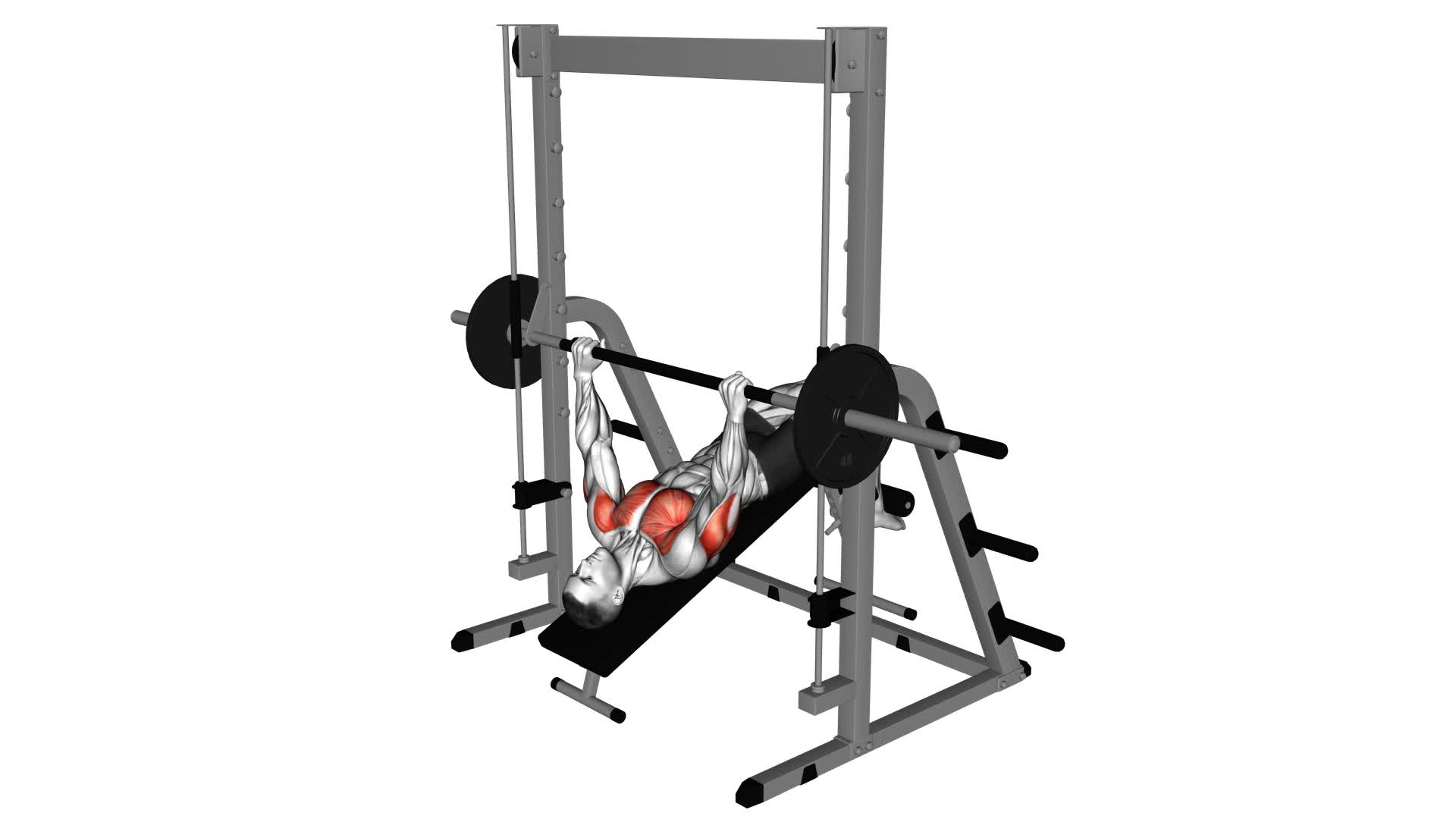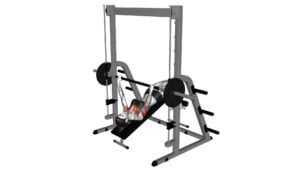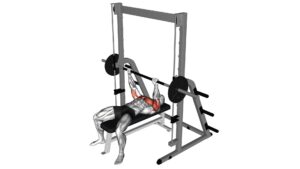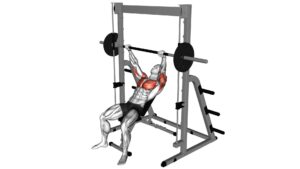Smith Decline Bench Press – Video Exercise Guide & Tips

Are you looking to take your upper body strength training to the next level?
Watch This Exercise Video
The Smith Decline Bench Press is a powerful exercise that targets your chest, shoulders, and triceps.
In this video exercise guide, we'll show you the proper form and technique to maximize your gains.
Whether you're a beginner or a seasoned lifter, our tips and variations will help you increase difficulty and target specific muscles.
Get ready to elevate your workout routine with the Smith Decline Bench Press.
Key Takeaways
- The Smith Decline Bench Press effectively targets lower chest muscles.
- Proper form and technique are crucial to avoid common mistakes such as arching the back excessively or using excessive momentum.
- Variations and modifications, such as the Incline Smith Decline Bench Press or the Single-Arm Smith Decline Bench Press, can be used to increase difficulty or target specific muscles.
- It is important to select an appropriate weight for proper form and to vary the grip to target different muscles.
Benefits of the Smith Decline Bench Press
One major benefit of the Smith Decline Bench Press is that it targets the lower chest muscles more effectively than traditional bench presses. This exercise variation allows you to specifically isolate and engage the lower pecs, leading to enhanced muscle development and definition in that area. By adjusting the decline angle of the bench, you can further customize the intensity and focus of the exercise.
The Smith Decline Bench Press also offers benefits in terms of stability and safety. The fixed barbell on the Smith machine guides your movements, reducing the risk of injury and helping you maintain proper form throughout the exercise. This is especially advantageous for beginners or individuals with limited experience in weightlifting.
Additionally, the Smith Decline Bench Press allows for greater load control. The machine's locking mechanism enables you to easily adjust the weight plates, making it convenient to increase or decrease resistance as needed. This feature is particularly useful for progressive overload training, a key principle for muscle growth.
Equipment Needed for the Exercise
To perform the Smith Decline Bench Press, you'll need a few pieces of equipment. Here are the essential items you'll need to have:
- Smith Machine: The Smith Machine is a weightlifting equipment that consists of a barbell fixed within steel rails. It provides stability and safety during the exercise, allowing you to focus solely on your form and technique.
- Decline Bench: A decline bench is specifically designed to target the lower chest muscles. It has an adjustable angle that allows you to decline the bench to a suitable position for the exercise.
- Weight Plates: You'll need weight plates to load onto the barbell. The amount of weight you choose will depend on your fitness level and goals.
- Collars: Collars are essential for securing the weight plates on the barbell. They prevent the plates from sliding off and ensure your safety during the exercise.
By having these four pieces of equipment, you'll be fully equipped to perform the Smith Decline Bench Press effectively and safely.
Now that you know what you need, let's move on to the next section, where we'll discuss proper form and technique for the Smith Decline Bench Press.
Proper Form and Technique for the Smith Decline Bench Press
To ensure proper form and technique during the Smith Decline Bench Press, it's crucial to focus on your shoulder positioning. Keep your shoulders back and down, avoiding any shrugging or hunching forward, to maintain stability and prevent strain on the shoulders.
Additionally, be aware of common mistakes such as arching the lower back or using excessive momentum, as these can compromise the effectiveness and safety of the exercise.
Shoulder Positioning During Decline
Maintain proper shoulder positioning during the decline phase of the Smith Decline Bench Press by keeping your shoulders back and engaged throughout the exercise. Proper technique and shoulder stability are essential for maximizing the benefits of this exercise.
Here are four important tips to help you maintain proper shoulder positioning:
- Set your shoulder blades: Before you begin the exercise, retract your shoulder blades by pulling them back and down. This will help stabilize your shoulders and maintain proper alignment.
- Engage your core: Keeping your core muscles engaged will provide additional stability to your shoulders. Contract your abdominal muscles and maintain a strong core throughout the exercise.
- Avoid excessive shoulder protraction: During the decline phase, be mindful of not allowing your shoulders to roll forward. Keep them pulled back and squeezed together to maintain stability.
- Use a controlled descent: Slowly lower the barbell to your chest, maintaining control throughout the movement. This will further engage your shoulder muscles and promote better shoulder stability.
Common Mistakes to Avoid
To ensure proper form and technique for the Smith Decline Bench Press, it's crucial to avoid common mistakes that can compromise your workout.
One common mistake to avoid is improper breathing. When performing the exercise, it's important to exhale as you push the barbell away from your body and inhale as you bring it back down. This helps to stabilize your core and maintain proper form throughout the movement.
Another mistake to avoid is improper spotting techniques. If you're lifting heavy weights, it's recommended to have a spotter to assist you in case you reach failure. A spotter can provide support and help you lift the weight safely, ensuring that you can complete your sets without compromising your form or risking injury.
Variations and Modifications to Increase Difficulty or Target Specific Muscles
Enhance the challenge and target specific muscles by incorporating variations and modifications into your Smith decline bench press routine. Here are four ways you can increase the difficulty or focus on different muscle groups:
- Incline Smith Decline Bench Press: Adjust the angle of the bench to target your upper chest and shoulders. This variation puts more emphasis on the front deltoids and upper pectoral muscles.
- Close Grip Smith Decline Bench Press: Bring your hands closer together on the barbell to increase the activation of your triceps. This modification shifts the focus from the chest to the back of your arms.
- Single-Arm Smith Decline Bench Press: Perform the exercise with one arm at a time to challenge your core stability and improve muscle imbalances. This variation also helps develop unilateral strength and coordination.
- Smith Decline Bench Press with Chains: Attach chains to the barbell to add variable resistance throughout the movement. As you lift the weight, the chains gradually lift off the ground, increasing the load and forcing your muscles to work harder.
Common Mistakes to Avoid During the Exercise
To avoid making common mistakes during the Smith decline bench press exercise, it's important that you pay attention to your form and technique. Proper form is crucial for maximizing the benefits of this exercise and preventing injuries.
One common mistake is flaring your elbows out to the sides during the movement. This puts unnecessary strain on your shoulders and can lead to discomfort or injury. Instead, keep your elbows tucked in close to your body throughout the exercise.
Another mistake to avoid is arching your back excessively. While a slight arch is natural and helps maintain stability, an excessive arch can strain your lower back. Maintain a neutral spine position throughout the movement.
It's also important to use a controlled and smooth motion during the exercise. Avoid bouncing the bar off your chest or using momentum to lift the weight. This not only reduces the effectiveness of the exercise but also increases the risk of injury.
Lastly, make sure to select an appropriate weight that allows you to maintain proper form throughout the set. Using excessive weight can compromise your form and increase the risk of injury.
Tips for Incorporating the Smith Decline Bench Press Into Your Workout Routine
To effectively incorporate the Smith decline bench press into your workout routine, consider using different variations of the exercise to target specific muscle groups. Here are four tips to help you maximize your results:
- Vary the grip: By altering your grip on the bar, you can shift the emphasis on different muscles. A wider grip targets the outer chest and shoulders, while a narrower grip focuses more on the triceps.
- Adjust the decline angle: Changing the angle of the bench allows you to target specific areas of the chest. A steeper decline emphasizes the lower chest, while a shallower decline places more emphasis on the upper chest.
- Incorporate pauses: Adding a pause at the bottom of the movement forces your muscles to work harder during the lift. This technique increases time under tension and can lead to greater muscle growth and strength gains.
- Use progressive overload: To continue progressing, gradually increase the weight you lift over time. This ensures that your muscles are constantly challenged and stimulated for growth.
By incorporating these strategies and muscle targeting techniques into your Smith decline bench press routine, you can optimize your workout and achieve your desired results.
Remember to always prioritize proper form and technique to minimize the risk of injury.
Frequently Asked Questions
How Many Sets and Reps Should I Do for the Smith Decline Bench Press?
To determine the number of sets and reps for the Smith decline bench press, consider your fitness goals and current fitness level. Aim for 2-4 sets of 8-12 reps to build muscle and strength.
Start with a weight you can handle with proper form and gradually increase as you get stronger. Remember to warm up before each session and rest for 1-2 minutes between sets.
This will help optimize your workout and avoid common mistakes.
Can I Use Dumbbells Instead of a Barbell for the Smith Decline Bench Press?
Yes, you can use dumbbells instead of a barbell for the Smith decline bench press. Using dumbbells for this exercise offers several benefits.
It allows for a greater range of motion, engages more stabilizer muscles, and can help identify and correct muscle imbalances. Additionally, using dumbbells can provide a more challenging workout because each arm has to work independently.
Can the Smith Decline Bench Press Help With Targeting the Lower Chest Muscles?
Yes, the Smith decline bench press can help you target your lower chest muscles effectively. By performing this exercise, you can activate and engage your lower chest muscles, promoting strength and growth in that area.
However, if you're looking for alternative exercises to specifically focus on your lower chest, you can try decline dumbbell press or decline push-ups. These exercises can also provide great lower chest activation and help you achieve your fitness goals.
Is the Smith Decline Bench Press Suitable for Beginners?
The Smith decline bench press is a great exercise for beginners, offering numerous benefits for targeting the lower chest muscles. To ensure proper form, start by adjusting the weight and positioning yourself on the decline bench.
Lower the bar to your lower chest, keeping your elbows tucked in and your back flat. Push the bar back up, focusing on engaging your chest muscles.
With practice, this exercise will help you build strength and muscle definition in your lower chest.
How Often Should I Do the Smith Decline Bench Press in My Workout Routine?
To determine the frequency of the Smith decline bench press in your workout routine, consider several factors.
First, assess your fitness level and goals. Beginners may start with 2-3 sessions per week, gradually increasing as strength improves.
Intermediate and advanced lifters can aim for 3-4 sessions per week. Remember to incorporate variations such as different grips or tempos to challenge your muscles.
Always listen to your body and allow for adequate rest and recovery between sessions.
Conclusion
Overall, the Smith Decline Bench Press is a highly effective exercise for targeting the chest, shoulders, and triceps.
By using the Smith machine, it provides stability and control, making it suitable for beginners or those with limited mobility.
However, it's important to maintain proper form and avoid common mistakes to prevent injuries.
Incorporating this exercise into your workout routine can help you build strength and muscle mass in your upper body.

Author
Years ago, the spark of my life’s passion ignited in my mind the moment I stepped into the local gym for the first time. The inaugural bead of perspiration, the initial endeavor, the very first surge of endorphins, and a sense of pride that washed over me post-workout marked the beginning of my deep-seated interest in strength sports, fitness, and sports nutrition. This very curiosity blossomed rapidly into a profound fascination, propelling me to earn a Master’s degree in Physical Education from the Academy of Physical Education in Krakow, followed by a Sports Manager diploma from the Jagiellonian University. My journey of growth led me to gain more specialized qualifications, such as being a certified personal trainer with a focus on sports dietetics, a lifeguard, and an instructor for wellness and corrective gymnastics. Theoretical knowledge paired seamlessly with practical experience, reinforcing my belief that the transformation of individuals under my guidance was also a reflection of my personal growth. This belief holds true even today. Each day, I strive to push the boundaries and explore new realms. These realms gently elevate me to greater heights. The unique combination of passion for my field and the continuous quest for growth fuels my drive to break new ground.







